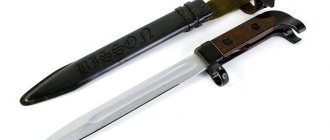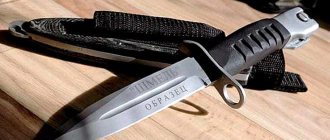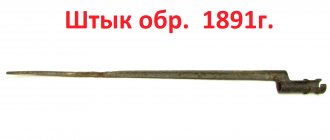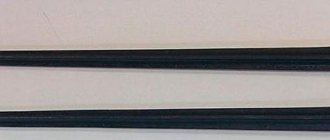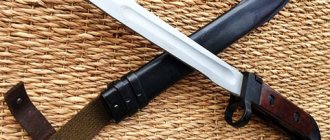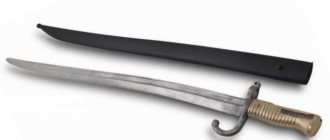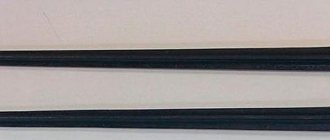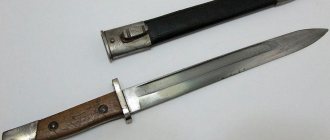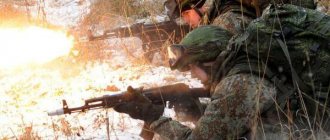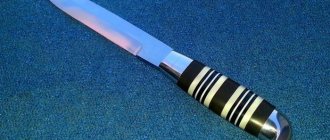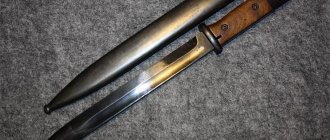The Kalashnikov assault rifles, adopted for service in 1949, were not equipped with bayonets. But since the military often used the machine gun in battle as a strike weapon, it was soon decided to develop a high-strength blade that could be fixed to the barrel. The AK-47 bayonet was produced along with the machine gun. It was first modernized only after the creation of the AKM. Subsequently, the model was refined several times. Numerous photographs confirm this fact. Different types of devices differed in technical characteristics.
The bayonet knife was used in close combat.
Design Features
The first bayonet was called a 6x2 product. It was put into service in 1955. Despite the fact that in the drawing the model looked like a bayonet, the design made it possible to use it as an army knife.
Since the first machines did not provide for the installation of additional devices, they had to be modified during scheduled repairs. Design features of the model:
- Single-edged blade. It had the shape of a spear and was equipped with fullers to facilitate the design.
- Riveted handle. Plastic covers were attached to it with a pair of screws.
The device was firmly fixed on the trunk:
- On the muzzle using a ring on the cross.
- On the stop of the gas chamber there is a T-shaped groove with a spring latch located in the head of the handle.
The total length of the bladed weapon is 315 mm, blade dimensions are 205x22 mm. Additionally, the bayonet-knife was equipped with a steel sheath. They were equipped with a loop and a strap for fixing on the belt.
History has not sunk into oblivion
The famous army knives NA-40 and NR-43 “Cherry” spent quite a long time in service with the Soviet Army. The army knife produced in 1940 remained in use as a weapon until the mid-60s of the last century, and the 43rd “Cherry” is still used to this day in a number of Russian security forces.
The HP-43 was very popular, which was taken into account by manufacturers of modern edged weapons. For example, Versmsky produces the HP-2000 product, the prototype of which was the famous “Cherry”.
Prototype of a modern AK bayonet model
The prototype of the first bayonet is a device developed for the SVT-40. This Soviet weapon was used in the USSR army from the first days of the Great Patriotic War.
The length of the prototype bayonet is 360 mm. The parameters of a single-edged blade with fullers on both sides are 240x24 mm. Other design features:
- The tip has a double-sided sharpening.
- The handle has two wooden cheeks. They are secured to the shank with a pair of rivets.
- The sheath is made of steel, equipped with a spring-loaded mouth and two suspension brackets.
For fixation on the barrel of the weapon, a ring installed on the side of the butt and a T-shaped groove with a spring latch on the head of the handle were used. There was a safety collar next to the button. The simple design ensured reliable fastening.
Modernization of the AK-47 bayonet
Modernized Kalashnikov assault rifles (AKM) were put into service in 1959. They were equipped with a new bayonet, which was called the 6x3 product. The total length of the bladed weapon was 280 mm, while the dimensions of the single-edged blade with a double-edged sharpening of the beveled combat end were 150x30 mm.
A modified version of the bayonet.
Thanks to the change in size, the device has become more convenient to use compared to the previous version. There are fewer differences between AK and AKM than in bayonets for these machine guns.
The design of the modernized device made it possible to deliver piercing and cutting blows during hand-to-hand combat. To solve additional problems, there was a rectangular hole in the middle part of the blade, and notches were made on the butt.
To make the sheath, a metal tube with a rectangular cross-section was used. A wide rubber pad was installed in the part adjacent to the handle.
During work operations it could be used as a handle. On the lower part, a metal part was fixed with rivets, serving as an additional blade. It had an axis for installing a knife.
Thanks to this design, edged weapons have become a universal cutting tool. In it, the main edge and the serrator on the butt were used for cutting various materials. By connecting a bayonet-knife to a scabbard on a T-shaped support, it was possible to obtain wire cutters. They could be used to organize passages through enemy wire barriers.
After some time, a 6x4 bayonet knife model appeared. Initially, it was also used for AKMs, and later the AK-74 was equipped with such a device. The blade in the model remained the same, the handle was modernized - it became more ergonomic.
The sheath was made of high-strength plastic. The 6x4 bayonet knife was modernized several times, but this had virtually no effect on its appearance. The total length was 270 mm and the weight was 250 g.
In 1989, an experimental model was developed for AK-74 assault rifles. It is believed that it became the prototype for the modern version.
The blade without a cut had a symmetrical spear-shaped combat end, which was distinguished by double-sided sharpening. The blade is thicker, but has been beveled to provide a thinner tip.
Experimental melee weapons were soon replaced by new versions. Today it can only be found in private collections. Modified souvenir models also appeared. These are ShNS bayonet knives, which differ from the original. Sometimes you can find folding models, but they are not considered real melee weapons.
Experimental versions can only be seen in collections.
Mosin rifle bayonets
In 1891, a new weapon was adopted by the Russian army - the Russian three-line rifle, created by S.I. Mosin. This rifle was supposed to replace the Berdanki, which had been in use since the early seventies. The new project used magazine ammunition, which provided significant superiority over existing weapons. At the same time, the new rifle received a bayonet based on a similar unit of the existing model. According to some reports, during the development of a promising weapon to replace the Berdan rifle, it was proposed to abandon the traditional needle bayonet and use a cleaver. However, supporters of proven solutions were able to defend the existing design and “push” for its use in the new project. At the same time, it was proposed not just to borrow a ready-made blade, but to create a new version of it, modified taking into account the experience of operating the weapon and the requirements for a promising rifle. Thus, from the point of view of general ideas, the Mosin rifle bayonet represented a further development of the Berdanka blade. It should be noted that later some rifles still received bayonets with knife-shaped blades, but this was a necessary measure.
Red Army soldiers learn bayonet fighting. Photo: Wikimedia Commons
The general architecture of the first bayonet for the Three-Ruler corresponded to the structure of the bayonet for the Berdan rifle. At the same time, the design was modified in accordance with new calculations and experience in the use of existing weapons. As a result, the dimensions and weight of the bayonet, as well as some of its elements, changed. To attach the bayonet to the rifle barrel, it was still proposed to use a tubular sleeve with a clamp. However, it was now proposed to attach the blade to the tube without any additional supports to ensure removal from the barrel. To attach the bayonet, a special stop on the barrel was no longer required.
The tubular bushing had a thickened rear end and a figured slot in the middle part. With the help of the latter, the bushing had to be in contact with the front sight, and also ensure the correct interaction of the clamp with the barrel. The bayonet was fixed to the barrel using a metal clamp with a screw. For ease of use of the weapon, the relatively long ends of the clamp were placed on the same side as the blade. The bayonet was installed on the barrel as follows. It was necessary to put the sleeve on the muzzle of the barrel and turn the bayonet to the desired angle clockwise. At the same time, the rotation angle, depending on the series and manufacturer, ranged from 30-90 degrees. The blade of the mounted bayonet was to the right of the barrel.
The blade of the new bayonet had a tetrahedral needle shape. For greater rigidity, there were fullers on the side surfaces of the bayonet. As before, only the tip was offered to be sharpened. Moreover, it had the shape of a screwdriver, which made it possible not only to attack the enemy, but also to use the bayonet as a screwdriver when servicing the weapon. The absence of sharpening on the side edges was supposed to ensure safe operation of the weapon with an attached bayonet.
Model 1891 bayonets. Photo Zemlyanka-bayonets.ru
The total length of the bayonet for the Three-Ruler was 500 mm - it was noticeably shorter than the bayonet of the Berdan rifle. The length of the tubular sleeve was 70-72 mm with an internal diameter of 15 mm. The blade accounted for 430 mm of the total length of the product. Due to some technical and technological differences, the weight of the bayonets varied within certain limits. Basically, this parameter ranged from 320-325 to 340-345 g.
It is known that the first batch of serial bayonets for the new rifle was ordered not from Russian industry, but from a foreign company. In 1891, an order for the production of rifles with bayonets was issued to the French factory Chatelleraut. From 1892 to 1895, this company supplied the Russian army with 509,539 rifles equipped with tetrahedral needle bayonets. French-made bayonets had some characteristic features, which, in particular, made them lighter than later products made in Russia.
The most noticeable difference between the French bayonets was the design of the blade's fullers. These indentations began immediately after attaching the blade to the tube, whereas on Russian bayonets there was a significant gap between the mounts and the fullers. Another difference was the shape of the part connecting the blade and the sleeve. Due to the wider slot in the tube, the bayonet had to be rotated 90° during installation. Finally, there were noticeable differences in the markings: the size of the letters, the location of the marks, etc.
Bushing for attaching a bayonet. Photo Zemlyanka-bayonets.ru
From the point of view of the main design features, the Mosin rifle bayonet was a further development of the Berdanka blade. Such features affected the manuals for the use of weapons. New rifles, like old ones, were prescribed to be shot with bayonets installed, which made it possible to reduce the effect of derivation during the flight of the bullet. The weapon should also be stored and carried with a bayonet. It was only necessary to remove it when traveling by rail or road. In all other situations, including during combat, the bayonet had to be located on the rifle barrel.
The first three-line rifles and bayonets for them were produced in France, but later the production of these weapons was transferred to Russian enterprises. Weapons were produced in Tula, Izhevsk and Sestroretsk. New domestic bayonets were produced in accordance with the project, but in appearance and design they differed from weapons manufactured by French industry.
The combat ends of the bayonets are made in the form of a screwdriver. Photo Zemlyanka-bayonets.ru
For several decades, bayonets for the Mosin rifle did not undergo any changes and, from a certain time, were produced only in Russia. However, later the list of manufacturing countries was supplemented with one more item. The outbreak of the First World War led to the need to increase the production of weapons, but the Russian industry could no longer cope with new orders. Because of this, contracts with American companies appeared. The Remington and Westinghouse factories were supposed to produce about 2.5 million rifles and the same number of bayonets. American-made weapons were similar to French ones and also had similar characteristics.
Before the revolutions of 1917, Russia managed to receive no more than 750-800 thousand American-made “Three-Lineers”. Due to the change of government and the difficult economic situation, the Russian side was unable to pay for and pick up new shipments of weapons, which caused problems with the status of these products. The problem was solved by the US government. Wanting to support factories that were experiencing economic difficulties, the state bought the rifles produced but not delivered to the customer and transferred them to the National Guard. Some of these weapons also ended up in the army. Since the acceptance of “unclaimed” rifles and bayonets was carried out by the American military, these weapons received the appropriate marks.
Bayonet mounts designed by Kabakov-Komaritsky. Photo Bayonet.lv
The development of a bayonet for a three-line rifle was not carried out until a certain time. New modifications of these weapons, including serial ones, appeared only after the creation of the Soviet Union. Over the next few decades, a number of modifications of the basic bayonet were created, differing from each other and from the original design in some features and even purpose. Some of the bayonet modifications successfully passed all the necessary tests and then entered production.
The first new modification of the bayonet was a training one. In the twenties, a new bayonet design was proposed, which allowed fighters, using appropriate protective equipment, to practice bayonet fighting techniques in joint exercises. The training bayonet differed from the combat bayonet in the design of the “blade” and its fastenings. The latter were made in the form of two metal plates with holes for two screws or rivets. Between the plates was placed a plate-like flexible bayonet simulator, fixed in place with screws/rivets. In terms of its dimensions, the flexible blade simulator corresponded to a military product. For safe use, the combat end of the simulator was bent and formed a loop.
Bayonet arr. 1891/30 Photo: Wikimedia Commons
According to some reports, flexible training bayonets were produced not only by arms factories, but also by sports equipment factories. In addition, there is information about the continued production of such products until the sixties. Training bayonets could be used with both combat and training Mosin rifles. During the Great Patriotic War, training bayonets were converted into combat bayonets: for this purpose, a homemade plate blade was installed in the mounts.
At the end of the twenties, work began on modernizing the “Three Line”, which led to the emergence of the so-called. Mosin rifle mod. 1891/30 One of the areas of modernization was the creation of a new bayonet, differing from the basic one in more advanced fastenings. Engineers Komaritsky and Kabakov created a new version of the system for installing a bayonet on a rifle, which included a spring latch and a muzzle designed by the gunsmith Panshin.
The new bayonet differed from the basic version in the design of its tubular sleeve. A large slot was provided on its side surface, connected to a small slot in the upper surface. Above the latter there was a large frame structure. The blade mount contained latch mechanisms. To install such a bayonet on a rifle, you had to put the tube on the barrel, sliding the front sight along the side slot, and then turn the bayonet 90° and put it on the latch. In this case, the blade was to the right of the barrel, and the open front sight was under the muzzle.
Bayonet mounts mod. 1891/30. Photo Bayonet.lv
In the near future, based on the design of Komaritsky-Kabakov, a new bayonet was developed, which was later used with a rifle mod. 1891/30 The design of the bayonet actually remained the same, but it lost its namusnik. During the modernization, the rifle received its own front sight protection, which made it possible to dispense with the corresponding part on the bayonet. In this configuration, the bayonet was mass-produced and supplied to the troops along with a modernized rifle. It is noteworthy that the bayonets of the first series were equipped with leather sheaths, but later they were abandoned due to the lack of need for such products.
In 1943, a new version of the bayonet with original fastenings was developed. As part of the competition for the development of a promising bayonet, a design was proposed that allows both dismantling the blade and folding it into a transport position. To do this, several new parts were installed on the tubular bushing. At the back there was a bracket with holes for a screw or pin. A blade with an elongated rear part was supposed to be hingedly mounted on it. At the muzzle level there was a movable latch part with a ring for installation on the barrel. Thus, the new bayonet had to be mounted on the rifle without the possibility of quick removal, but it became possible to fold the blade. To move it to the stowed position, the latch was moved forward and released the blade, allowing it to be rotated on its axis. The blade was laid along the bed. Returning to the firing position was done by turning forward and then installing the latch.
According to some reports, such bayonets were produced in a relatively small series and were used only in tests. They did not go into production, but became the basis for a new bayonet, which, in turn, was produced in large quantities and used by the troops.
Bayonet fastening mechanism for carbine mod. 1944 Photo: Wikimedia Commons
For certain reasons, a new folding bayonet began to be produced in 1943, but in documents it is listed as a bayonet mod. 1944. This version of the blade was intended for Mosin carbines and, above all, differed in dimensions. At the same time, there were differences in design. So, instead of a tube with a shaped slot, a metal clamp with a hinge for the blade was used, rigidly mounted on the barrel. The latch for fixing to the muzzle remains the same. The total length of such a folding bayonet was 380 mm with a blade length of 310 mm.
A folding bayonet with rigid non-removable fastenings was used only on Mosin carbines mod. 1944. These weapons were mass-produced and supplied to the Red Army. In addition, part of the stock of carbines was subsequently transferred to friendly states. Also, as part of international cooperation, the USSR transferred production documentation to third countries. The production of licensed carbines was carried out in Hungary, China and other countries.
During the war, improvised modifications of bayonets for the Mosin rifle were also created, built on the basis of existing parts. Thus, in Leningrad during the siege (according to other sources, in field workshops) bayonets with knife-like blades were made. In this case, a triangular mount was installed on the tubular sleeve, to which the blade was welded. The latter could be used as blanks for SVT-40 rifle bayonets or other similar products. Such blades had one-sided sharpening and fullers on both side surfaces. For obvious reasons, the dimensions and weight of such products differed markedly and depended on the “raw materials”.
An improvised makeshift bayonet made using a non-standard blade. Photo Bayonet.lv
Rifles S.I. Mosin rifles in various versions were produced until the mid-sixties of the last century and for several decades were one of the main types of small arms of the Russian and then the Red Army. During this time, several modifications of the weapon itself, as well as bayonets for it, were created. Depending on the requirements of the troops, removable or folding bayonets of various designs were developed, and if necessary, even an improvised modification was created that could be produced in conditions of scarce resources. Being an integral element of the rifle complex, Mosin rifle bayonets were actively used by soldiers during several wars. Thus, the bayonets of these weapons are no less worthy of consideration and study than the rifles themselves.
Based on materials from the sites: https://world.guns.ru/ https://bayonet.lv/ https://zemlyanka-bayonets.ru/ https://1941-1945.ru/ https://army.lv/
Detailed review of various bayonets for the “Three Line” with photographs: https://zemlyanka-bayonets.ru/forums/index.php?/topic/652-bayonet-to-Mosin-screw-mod.1891-goda /
Bayonet AK 74 6x5 modern model
In the process of the long evolution of the product, until 1986, an innovative product appeared - a 6x5 bayonet for the AK 74 and its brother AK 74M. The development of production and the development of the new PA-6 polyamide allowed designers to replace parts of the body kit on machine guns and light machine guns. The AK 74 6x5 bayonet was also not spared. There are three versions of them, let's look at each in more detail.
Bayonet AK 74 6x5 first version
The primary objectives for the designers were: reducing the cost of production and improving the performance characteristics of the product. The 6x5 bayonet has an original design, radically different from previous models. According to the documents, it looked like a simplified model.
The main difference from previous cutters was the spear-shaped shape of the blade and the absence of an oval hole near the tip. It was intended to cut through the wire when connecting to the scabbard. Another solution for such manipulations was used.
The scabbard had a hole in the bottom through which the tip of the blade was threaded. The result was wire cutters, but this solution was not developed. The design was tested in airborne units during the war in Afghanistan. And in combat conditions it became clear that the previous version of the instrument was more reliable and convenient.
On the left is the AK 74 6x5 bayonet of the first sample, on the right are the subsequent ones.
The handle of the bayonet for the AK 74 6x5 was transformed, the latch button was placed on it and the steel tip on the pommel was removed. The strap was excluded as unnecessary. During manufacturing, the blade was tightly fused to the handle with polyamide. The file on the cutter was located in the same place, but with simplified teeth. The length of the wedge has increased by 10 mm.
Bayonet AK 74 6x5 second modification
Information about the problematic design solution with wire cutters quickly reached the developers. Already in 1987, the 6x5 bayonet received a hole at the tip. The handle has acquired a more ergonomic shape. There are special recesses in the guard area.
The second version is dark cherry color.
They prevent the polyamide from rubbing off when the bayonet is carried in a sheath. The blade remained spear-shaped and the same length. We lengthened the file, its length almost to the hole along the cutting edge. Today the AK 74 6x5 bayonet of the second type is quite rare. Its rapid modernization into the next generation contributed to this phenomenon.
AK 74 6x5 bayonet third and final option
Production of the 6x5 bayonet in the third type began in 1988. The blade has not received any changes in this modification. The reconstruction touched the handle. It has become more ergonomic and grippy thanks to an increase in the hollows under the fingers and a change in their radius to a smaller side.
The first products were marked with a serial number at the bottom of the handle. In later versions it was moved closer to the blade. There are bayonets for AK 74 6x5 with a rough handle; they belong to the early varieties of products.
Product 6x2 in practice
The AK-47 bayonet (photo above) has proven itself to be a reliable and extremely convenient weapon for hand-to-hand combat.
The knife incorporates the best elements of Soviet combat knives. It fits comfortably in the hand, and the length of the blade of this product was not chosen by chance - the knife balances perfectly when working with it. Interestingly, the blade steel of this model is much softer than later modifications. In this regard, the AK-47 USSR bayonet does not break during knife fighting, and also withstands strong blows and falls on a hard surface. Initially, it was not intended that the 47th bayonet model would be used for biting wire or cutting metal, so there are no special design solutions in it. But, being both on the machine gun and in the hand of a fighter, it hits the enemy equally well.
Latest Developments
In 2010, a mock-up and then a sample of the Shmel bayonet appeared. The original model has an asymmetrical double-edged blade and a rubber handle. It has six grooves, which guarantees a secure grip. Textolite was used to make the sheath. The set includes a sharpening stone. Fixation is traditionally done using:
- a cross with a ring, which is installed on the blade side;
- T-slot with spring latch on the head of the handle.
The Russian 6X9-1 bayonet is a component of the Ratnik combat equipment. When creating it, a titanium nanocomposite coating was used. Thanks to special processing, unmasking glare is reduced.
Bayonet knife 6x9.
The cutting edge is distinguished by differentiated double-sided sharpening. Short fullers reduce the weight of the model. The sheath is made of impact-resistant plastic. They have a mechanism that allows you to cut through steel wire. Additionally, a diamond stone is installed for straightening the cutting edge.
"Black Knife Division"
In 1943, at the Zlatoust Tool Plant, workers produced a batch of blades that were an almost exact copy of the 40th model of an army knife. However, these knives differed from the NA-40 in that they were black in color. 3,356 copies of the blades were handed over to the soldiers of the volunteer tank corps in the Urals.
When the fighters arrived at the front, they were immediately called the “black knife division” by German intelligence because of the unusual color of the sheath and handle. The fighters of the Schwarzmesser Division fought desperately in battle. For military services, the volunteer tank corps received the title of “Guards.”
Practical use
Various operations are performed using a bayonet knife. If necessary, it can easily be converted into the following tools:
- hammer;
- wire cutters;
- scissors;
- saw;
- screwdriver
At the bottom of the sheath, the corner of the plastic has a rough cut. Using it, you can light a match or strike a spark from a mineral stone with one movement.
Using melee weapons you can create a spear. All you need to do is find a suitable shaft and attach a bayonet-knife to its end. This device is convenient to use for hunting and fishing.
Using a special clamp that fits onto a metal protrusion in the sheath, the bayonet-knife can be used as a torch. The oiled cloth is fixed to the structure and can be used without the risk of burning your hands.
Requirements for edged weapons
Since an AK bayonet is a bladed weapon, according to the law, intelligence officers have the right to carry it when performing their official duties. In all other cases, permission is required. It can be received by:
- citizens whose activities are related to hunting;
- military personnel who received the item as a trophy.
Violation of the rules is subject to confiscation of the item and an administrative fine. Melee weapons must be stored in a case and in a closed place specially designed for such purposes.
Previous
Combat knivesCombat knife "Caiman" - a dangerous dagger in the hands of a scout
Next
KnivesSelf-defense against a knife - basic techniques and their effectiveness
About the famous “NKVD knife”
Ordinary Soviet citizens were prohibited from carrying knives. However, this did not apply to party workers and NKVD employees, who in 1935 received Finnish knives produced by Vachin craftsmen as special means for self-defense. The production of this bladed weapon was based on one of the models of Swedish knives from the Holmberg company.
“Holmberg Finns” were banned by the state for use by the population. There are fullers on both sides of the knife, and a guard in front of the handle. The handle of the product was carbolite. It was believed that this knife was very convenient when working in close combat and when holding it with various grips. The “NKVD Knife” served as the prototype of the edged weapon of Soviet soldiers in early 1940.
